brake fluid YAMAHA YZ250F 2008 Betriebsanleitungen (in German)
[x] Cancel search | Manufacturer: YAMAHA, Model Year: 2008, Model line: YZ250F, Model: YAMAHA YZ250F 2008Pages: 192, PDF-Größe: 7.03 MB
Page 8 of 192
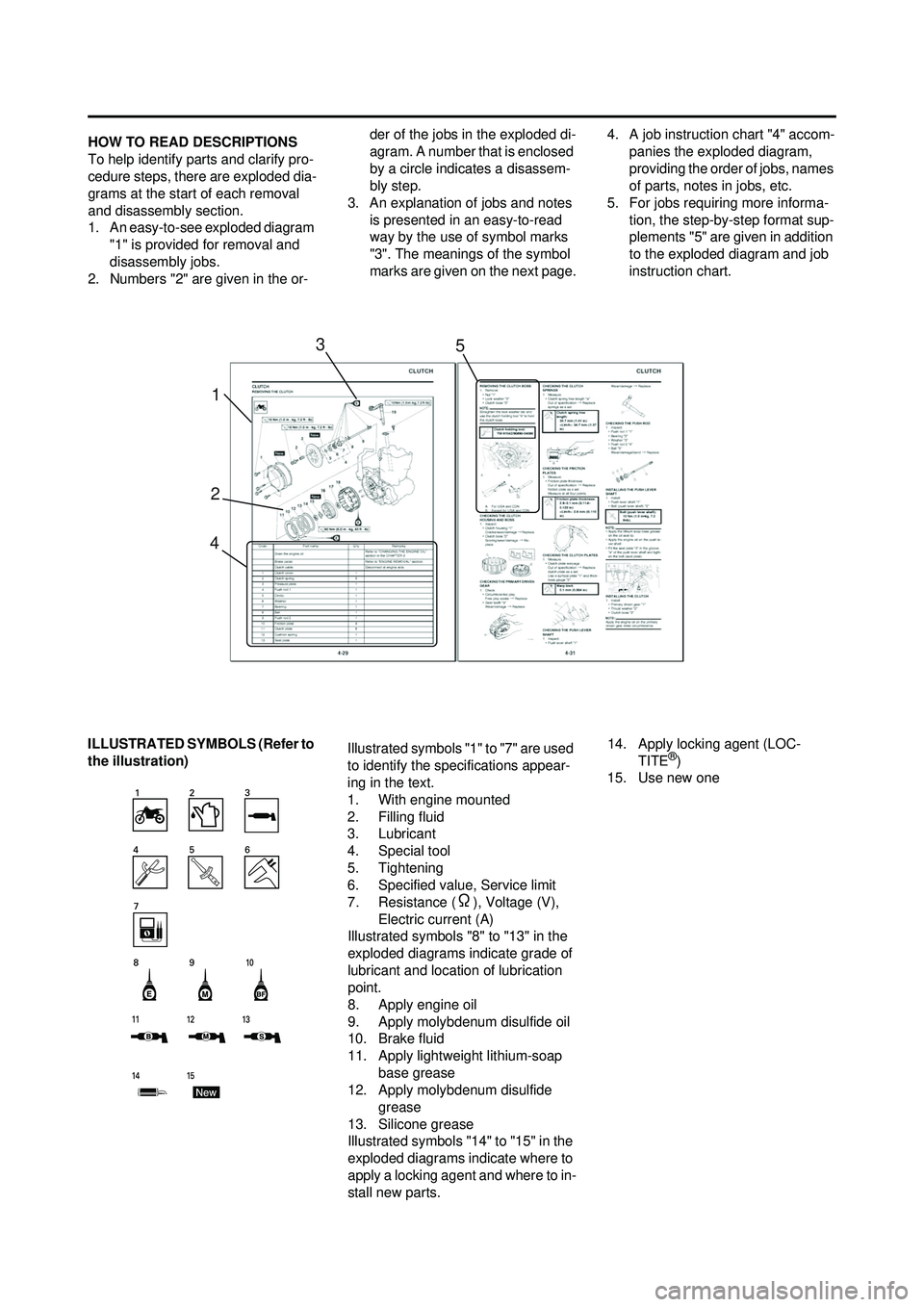
HOW TO READ DESCRIPTIONS
To help identify parts and clarify pro-
cedure steps, there are exploded dia-
grams at the start of each removal
and disassembly section.
1. An easy-to-see exploded diagram "1" is provided for removal and
disassembly jobs.
2. Numbers "2" are given in the or- der of the jobs in the exploded di-
agram. A number that is enclosed
by a circle indicates a disassem-
bly step.
3. An explanation of jobs and notes is presented in an easy-to-read
way by the use of symbol marks
"3". The meanings of the symbol
marks are given on the next page. 4. A job instruction chart "4" accom-
panies the exploded diagram,
providing the order of jobs, names
of parts, notes in jobs, etc.
5. For jobs requiring more informa- tion, the step-by-step format sup-
plements "5" are given in addition
to the exploded diagram and job
instruction chart.
ILLUSTRATED SYMBOLS (Refer to
the illustration) Illustrated symbols "1" to "7" are used
to identify the specifications appear-
ing in the text.
1. With engine mounted
2. Filling fluid
3. Lubricant
4. Special tool
5. Tightening
6. Specified value, Service limit
7. Resistance (
Ω), Voltage (V),
Electric current (A)
Illustrated symbols "8" to "13" in the
exploded diagrams indicate grade of
lubricant and location of lubrication
point.
8. Apply engine oil
9. Apply molybdenum disulfide oil
10. Brake fluid
11. Apply lightweight lithium-soap
base grease
12. Apply molybdenum disulfide
grease
13. Silicone grease
Illustrated symbols "14" to "15" in the
exploded diagrams indicate where to
apply a locking agent and where to in-
stall new parts. 14. Apply locking agent (LOC-
TITE
®)
15. Use new one
1
2 3
4 5
Page 31 of 192
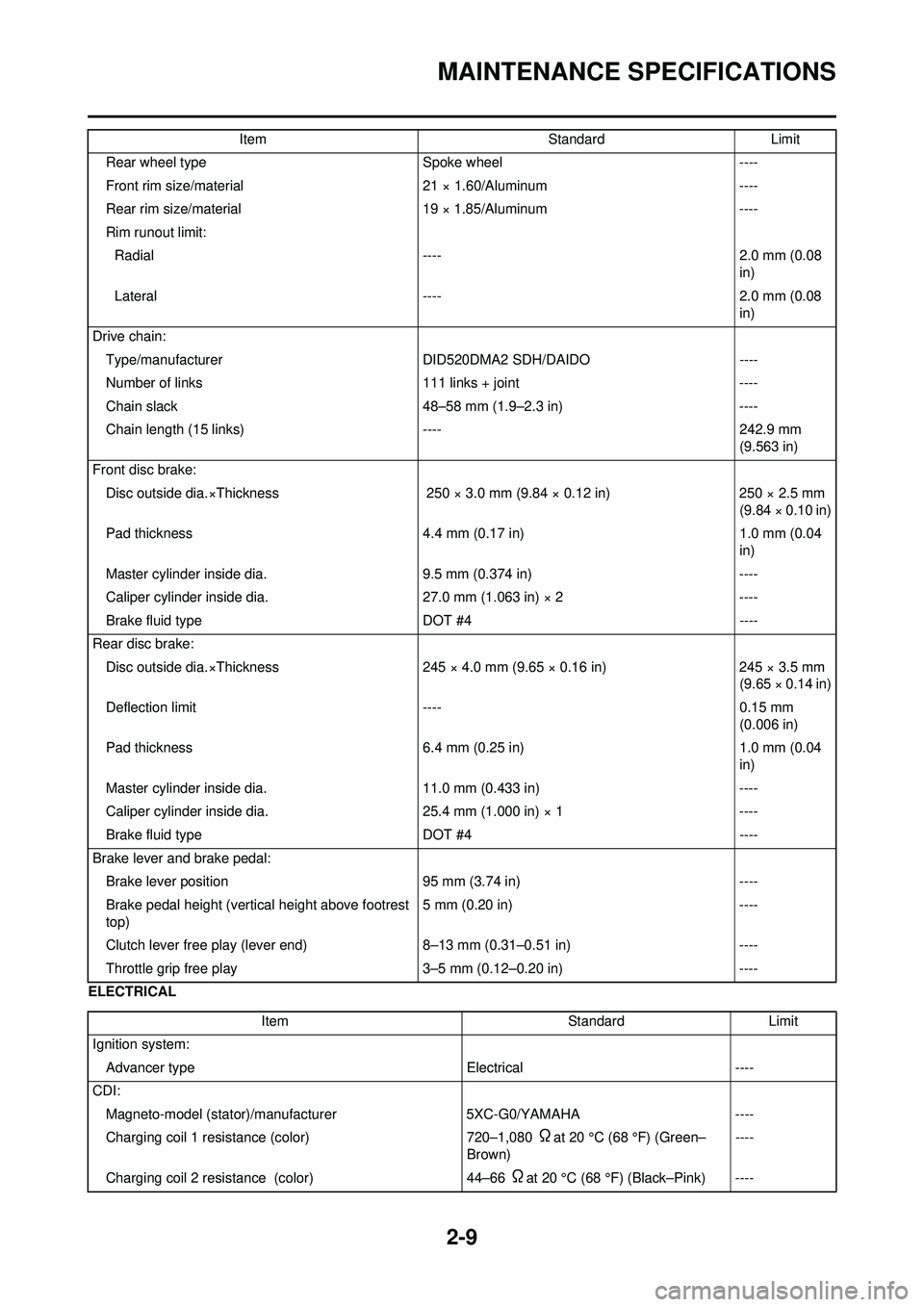
2-9
MAINTENANCE SPECIFICATIONS
ELECTRICALRear wheel type
Spoke wheel----
Front rim size/material 21 × 1.60/Aluminum----
Rear rim size/material 19 × 1.85/Aluminum----
Rim runout limit: Radial ---- 2.0 mm (0.08
in)
Lateral ---- 2.0 mm (0.08
in)
Drive chain: Type/manufacturer DID520DMA2 SDH/DAIDO ----
Number of links 111 links + joint----
Chain slack 48–58 mm (1.9–2.3 in)----
Chain length (15 links) ----242.9 mm
(9.563 in)
Front disc brake: Disc outside dia.×Thickness 250 × 3.0 mm (9.84 × 0.12 in)250 × 2.5 mm
(9.84 × 0.10 in)
Pad thickness 4.4 mm (0.17 in)1.0 mm (0.04
in)
Master cylinder inside dia. 9.5 mm (0.374 in)----
Caliper cylinder inside dia. 27.0 mm (1.063 in) × 2----
Brake fluid type DOT #4----
Rear disc brake: Disc outside dia.×Thickness 245 × 4.0 mm (9.65 × 0.16 in)245 × 3.5 mm
(9.65 × 0.14 in)
Deflection limit ----0.15 mm
(0.006 in)
Pad thickness 6.4 mm (0.25 in)1.0 mm (0.04
in)
Master cylinder inside dia. 11.0 mm (0.433 in)----
Caliper cylinder inside dia. 25.4 mm (1.000 in) × 1----
Brake fluid type DOT #4----
Brake lever and brake pedal: Brake lever position 95 mm (3.74 in)----
Brake pedal height (vertical height above footrest
top) 5 mm (0.20 in)
----
Clutch lever free play (lever end) 8–13 mm (0.31–0.51 in)----
Throttle grip free play 3–5 mm (0.12–0.20 in)----
Item
StandardLimit
Item StandardLimit
Ignition system: Advancer type Electrical----
CDI: Magneto-model (stator)/manufacturer 5XC-G0/YAMAHA----
Charging coil 1 resistance (color) 720–1,080
Ωat 20 °C (68 °F) (Green–
Brown) ----
Charging coil 2 resistance (color) 44–66
Ωat 20 °C (68 °F) (Black–Pink) ----
Page 49 of 192

3-3
MAINTENANCE INTERVALS
OIL STRAINERClean
●
FRAMEClean and inspect
●●
FUEL TANK, COCKClean and inspect
●●
BRAKESAdjust lever position and pedal
height
●●
Lubricate pivot point●●
Check brake disc surface●●
Check fluid level and leakage●●
Retighten brake disc bolts, cali-
per bolts, master cylinder bolts
and union bolts●●
Replace pads●
Replace brake fluid●Every one year
FRONT FORKS Inspect and adjust
●●
Replace oil●●Suspension oil "S1"
Replace oil seal
●
FRONT FORK OIL SEAL AND
DUST SEAL Clean and lube
●●Lithium base grease
PROTECTOR GUIDE Replace
●
REAR SHOCK ABSORBERInspect and adjust
●●
Lube●
(After rain
ride)
●Molybdenum disulfide grease
Replace spring seat
●Every one year
Retighten
●●
DRIVE CHAIN GUIDE AND
ROLLERS Inspect
●●
SWINGARMInspect, lube and retighten
●●Molybdenum disulfide grease
RELAY ARM, CONNECTING
ROD Inspect, lube and retighten
●●Molybdenum disulfide grease
STEERING HEAD Inspect free play and retighten
●●
Clean and lube●Lithium base grease
Replace bearing
●
Item After
break-
in Every
race
Every third
(or 500 km) Every
fifth (or 1,000 km)
As re-
quired Remarks
Page 60 of 192
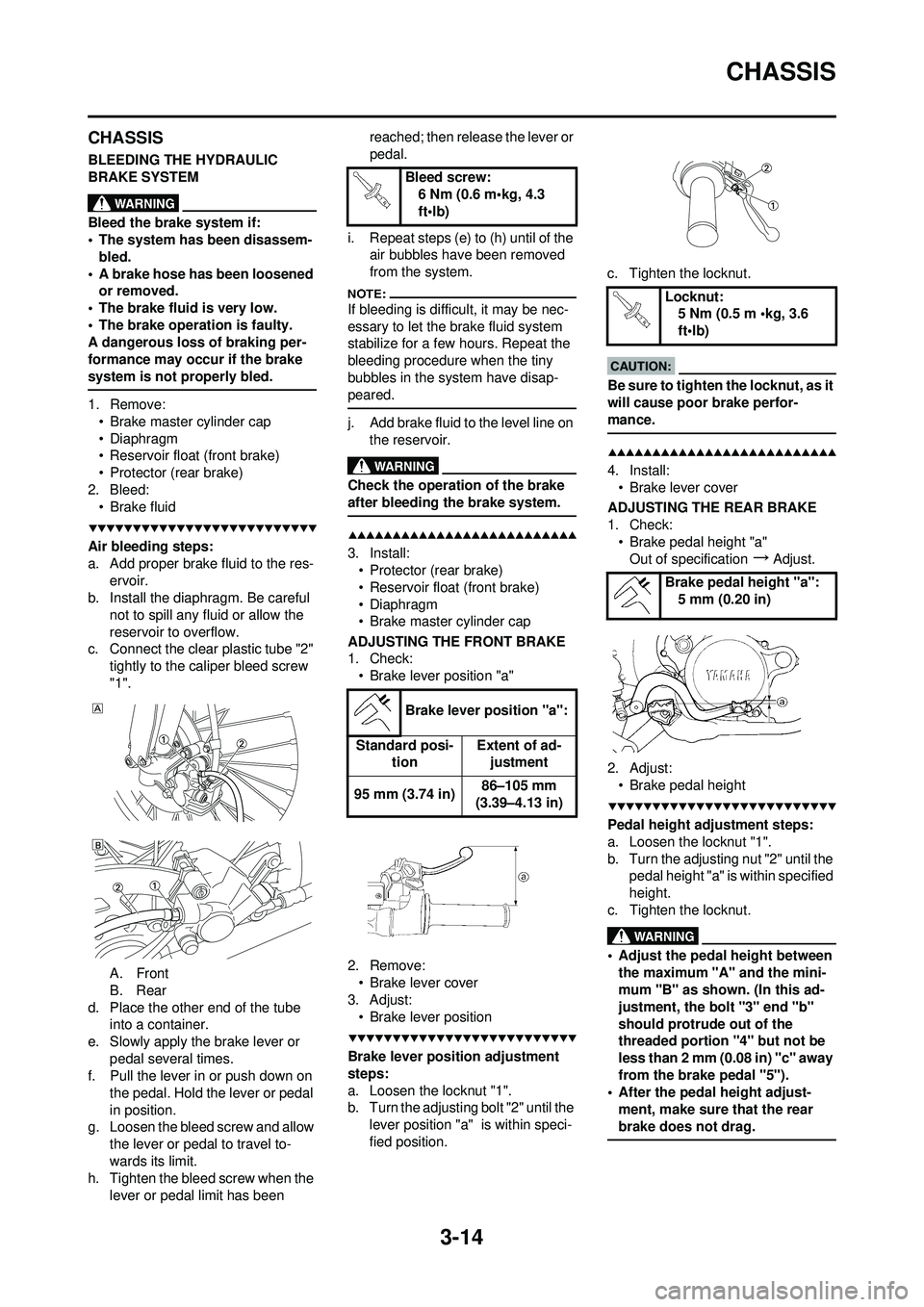
3-14
CHASSIS
CHASSIS
BLEEDING THE HYDRAULIC
BRAKE SYSTEM
Bleed the brake system if:
• The system has been disassem-bled.
• A brake hose has been loosened or removed.
• The brake fluid is very low.
• The brake operation is faulty.
A dangerous loss of braking per-
formance may occur if the brake
system is not properly bled.
1. Remove: • Brake master cylinder cap
• Diaphragm
• Reservoir float (front brake)
• Protector (rear brake)
2. Bleed: • Brake fluid
Air bleeding steps:
a. Add proper brake fluid to the res-
ervoir.
b. Install the diaphragm. Be careful
not to spill any fluid or allow the
reservoir to overflow.
c. Connect the clear plastic tube "2"
tightly to the caliper bleed screw
"1".
A. Front
B. Rear
d. Place the other end of the tube into a container.
e. Slowly apply the brake lever or pedal several times.
f. Pull the lever in or push down on
the pedal. Hold the lever or pedal
in position.
g. Loosen the bleed screw and allow
the lever or pedal to travel to-
wards its limit.
h. Tighten the bleed screw when the
lever or pedal limit has been reached; then release the lever or
pedal.
i. Repeat steps (e) to (h) until of the air bubbles have been removed
from the system.
If bleeding is difficult, it may be nec-
essary to let the brake fluid system
stabilize for a few hours. Repeat the
bleeding procedure when the tiny
bubbles in the system have disap-
peared.
j. Add brake fluid to the level line on
the reservoir.
Check the operation of the brake
after bleeding the brake system.
3. Install:• Protector (rear brake)
• Reservoir float (front brake)
• Diaphragm
• Brake master cylinder cap
ADJUSTING THE FRONT BRAKE
1. Check: • Brake lever position "a"
2. Remove: • Brake lever cover
3. Adjust: • Brake lever position
Brake lever position adjustment
steps:
a. Loosen the locknut "1".
b. Turn the adjusting bolt "2" until the lever position "a" is within speci-
fied position. c. Tighten the locknut.
Be sure to tighten the locknut, as it
will cause poor brake perfor-
mance.
4. Install:
• Brake lever cover
ADJUSTING THE REAR BRAKE
1. Check: • Brake pedal height "a"Out of specification
→Adjust.
2. Adjust: • Brake pedal height
Pedal height adjustment steps:
a. Loosen the locknut "1".
b. Turn the adjusting nut "2" until the pedal height "a" is within specified
height.
c. Tighten the locknut.
• Adjust the pedal height between the maximum "A" and the mini-
mum "B" as shown. (In this ad-
justment, the bolt "3" end "b"
should protrude out of the
threaded portion "4" but not be
less than 2 mm (0.08 in) "c" away
from the brake pedal "5").
• After the pedal height adjust-
ment, make sure that the rear
brake does not drag.
Bleed screw: 6 Nm (0.6 m•kg, 4.3
ft•lb)
Brake lever position "a":
Standard posi- tion Extent of ad-
justment
95 mm (3.74 in) 86–105 mm
(3.39–4.13 in)
Locknut: 5 Nm (0.5 m •kg, 3.6
ft•lb)
Brake pedal height "a": 5 mm (0.20 in)
Page 61 of 192
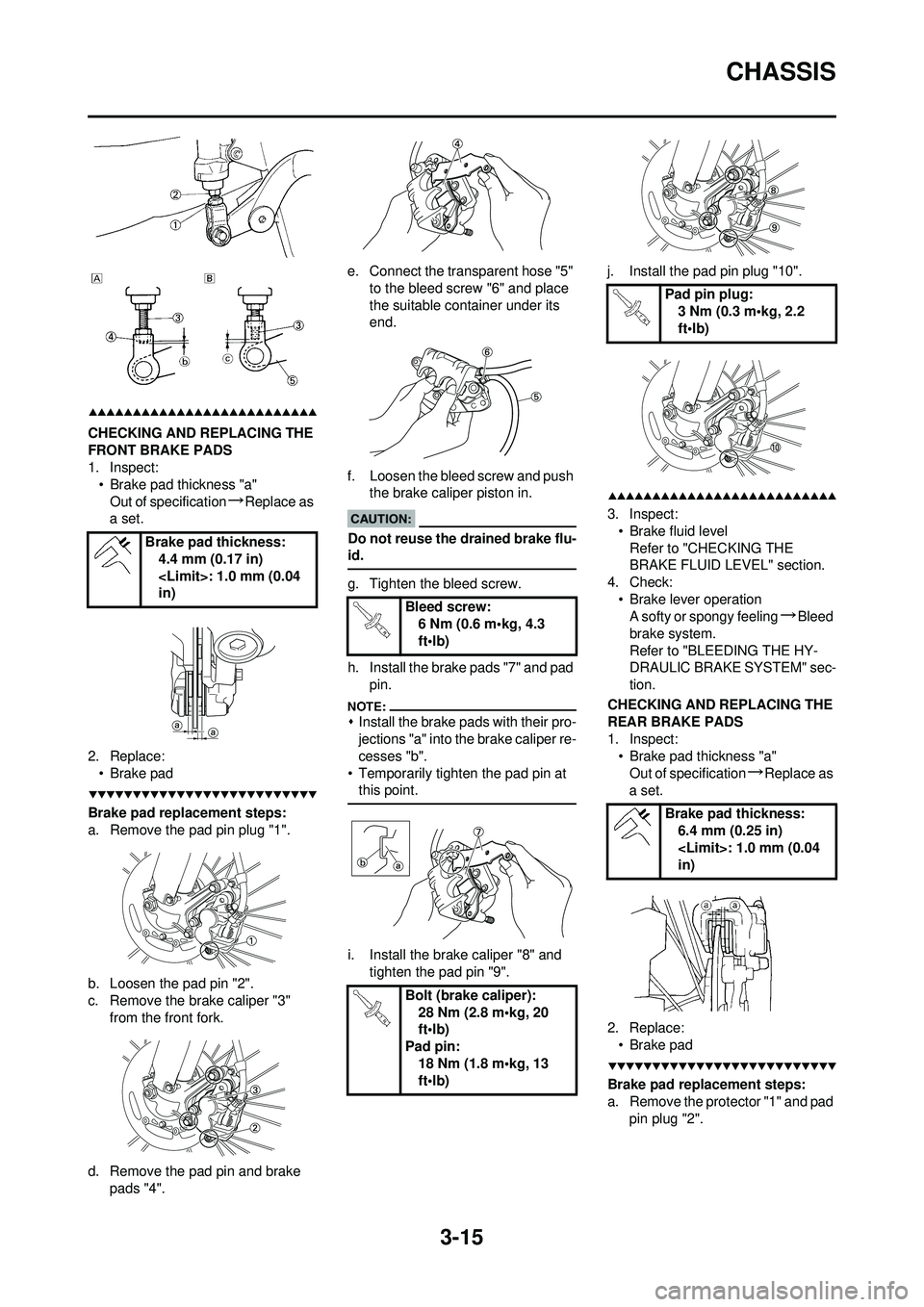
3-15
CHASSIS
CHECKING AND REPLACING THE
FRONT BRAKE PADS
1. Inspect:• Brake pad thickness "a"Out of specification
→Replace as
a set.
2. Replace: •Brake pad
Brake pad replacement steps:
a. Remove the pad pin plug "1".
b. Loosen the pad pin "2".
c. Remove the brake caliper "3" from the front fork.
d. Remove the pad pin and brake pads "4". e. Connect the transparent hose "5"
to the bleed screw "6" and place
the suitable container under its
end.
f. Loosen the bleed screw and push the brake caliper piston in.
Do not reuse the drained brake flu-
id.
g. Tighten the bleed screw.
h. Install the brake pads "7" and pad
pin.
�ŒInstall the brake pads with their pro-
jections "a" into the brake caliper re-
cesses "b".
• Temporarily tighten the pad pin at this point.
i. Install the brake caliper "8" and
tighten the pad pin "9". j. Install the pad pin plug "10".
3. Inspect:
• Brake fluid levelRefer to "CHECKING THE
BRAKE FLUID LEVEL" section.
4. Check: • Brake lever operationA softy or spongy feeling
→Bleed
brake system.
Refer to "BLEEDING THE HY-
DRAULIC BRAKE SYSTEM" sec-
tion.
CHECKING AND REPLACING THE
REAR BRAKE PADS
1. Inspect: • Brake pad thickness "a"
Out of specification
→Replace as
a set.
2. Replace: • Brake pad
Brake pad replacement steps:
a. Remove the protector "1" and pad pin plug "2".
Brake pad thickness:
4.4 mm (0.17 in)
in)
Bleed screw:6 Nm (0.6 m•kg, 4.3
ft•lb)
Bolt (brake caliper): 28 Nm (2.8 m•kg, 20
ft•lb)
Pad pin: 18 Nm (1.8 m•kg, 13
ft•lb)
Pad pin plug:3 Nm (0.3 m•kg, 2.2
ft•lb)
Brake pad thickness: 6.4 mm (0.25 in)
in)
Page 62 of 192
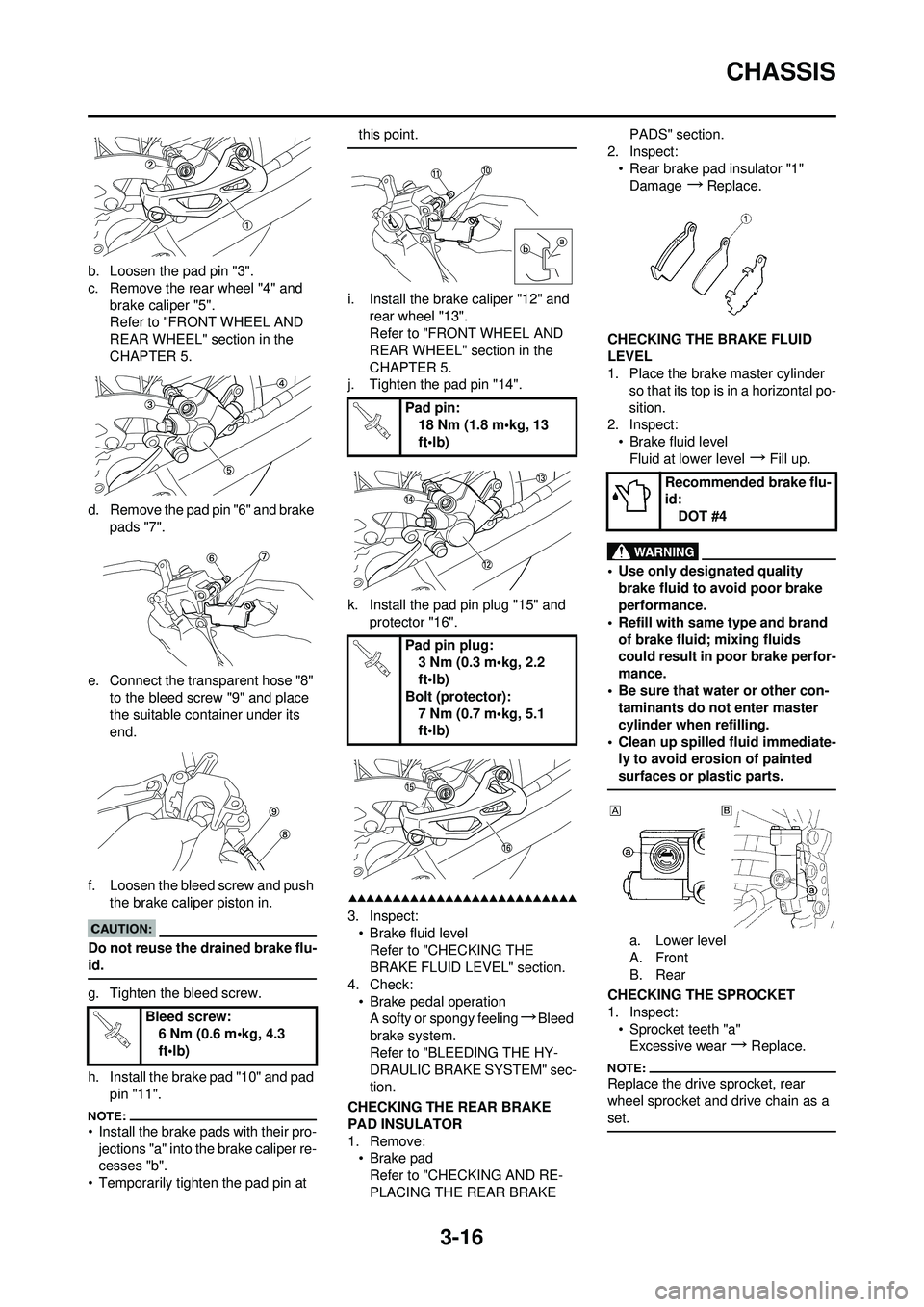
3-16
CHASSIS
b. Loosen the pad pin "3".
c. Remove the rear wheel "4" and brake caliper "5".
Refer to "FRONT WHEEL AND
REAR WHEEL" section in the
CHAPTER 5.
d. Remove the pad pin "6" and brake pads "7".
e. Connect the transparent hose "8" to the bleed screw "9" and place
the suitable container under its
end.
f. Loosen the bleed screw and push the brake caliper piston in.
Do not reuse the drained brake flu-
id.
g. Tighten the bleed screw.
h. Install the brake pad "10" and pad pin "11".
• Install the brake pads with their pro-jections "a" into the brake caliper re-
cesses "b".
• Temporarily tighten the pad pin at this point.
i. Install the brake caliper "12" and
rear wheel "13".
Refer to "FRONT WHEEL AND
REAR WHEEL" section in the
CHAPTER 5.
j. Tighten the pad pin "14".
k. Install the pad pin plug "15" and
protector "16".
3. Inspect:• Brake fluid levelRefer to "CHECKING THE
BRAKE FLUID LEVEL" section.
4. Check: • Brake pedal operationA softy or spongy feeling
→Bleed
brake system.
Refer to "BLEEDING THE HY-
DRAULIC BRAKE SYSTEM" sec-
tion.
CHECKING THE REAR BRAKE
PAD INSULATOR
1. Remove: •Brake pad
Refer to "CHECKING AND RE-
PLACING THE REAR BRAKE PADS" section.
2. Inspect: • Rear brake pad insulator "1"Damage
→Replace.
CHECKING THE BRAKE FLUID
LEVEL
1. Place the brake master cylinder so that its top is in a horizontal po-
sition.
2. Inspect:
• Brake fluid levelFluid at lower level
→Fill up.
• Use only designated quality brake fluid to avoid poor brake
performance.
• Refill with same type and brand of brake fluid; mixing fluids
could result in poor brake perfor-
mance.
• Be sure that water or other con- taminants do not enter master
cylinder when refilling.
• Clean up spilled fluid immediate- ly to avoid erosion of painted
surfaces or plastic parts.
a. Lower level
A. Front
B. Rear
CHECKING THE SPROCKET
1. Inspect: • Sprocket teeth "a"Excessive wear
→Replace.
Replace the drive sprocket, rear
wheel sprocket and drive chain as a
set.
Bleed screw:
6 Nm (0.6 m•kg, 4.3
ft•lb)
Pad pin:18 Nm (1.8 m•kg, 13
ft•lb)
Pad pin plug: 3 Nm (0.3 m•kg, 2.2
ft•lb)
Bolt (protector): 7 Nm (0.7 m•kg, 5.1
ft•lb)
Recommended brake flu-
id:DOT #4
Page 138 of 192
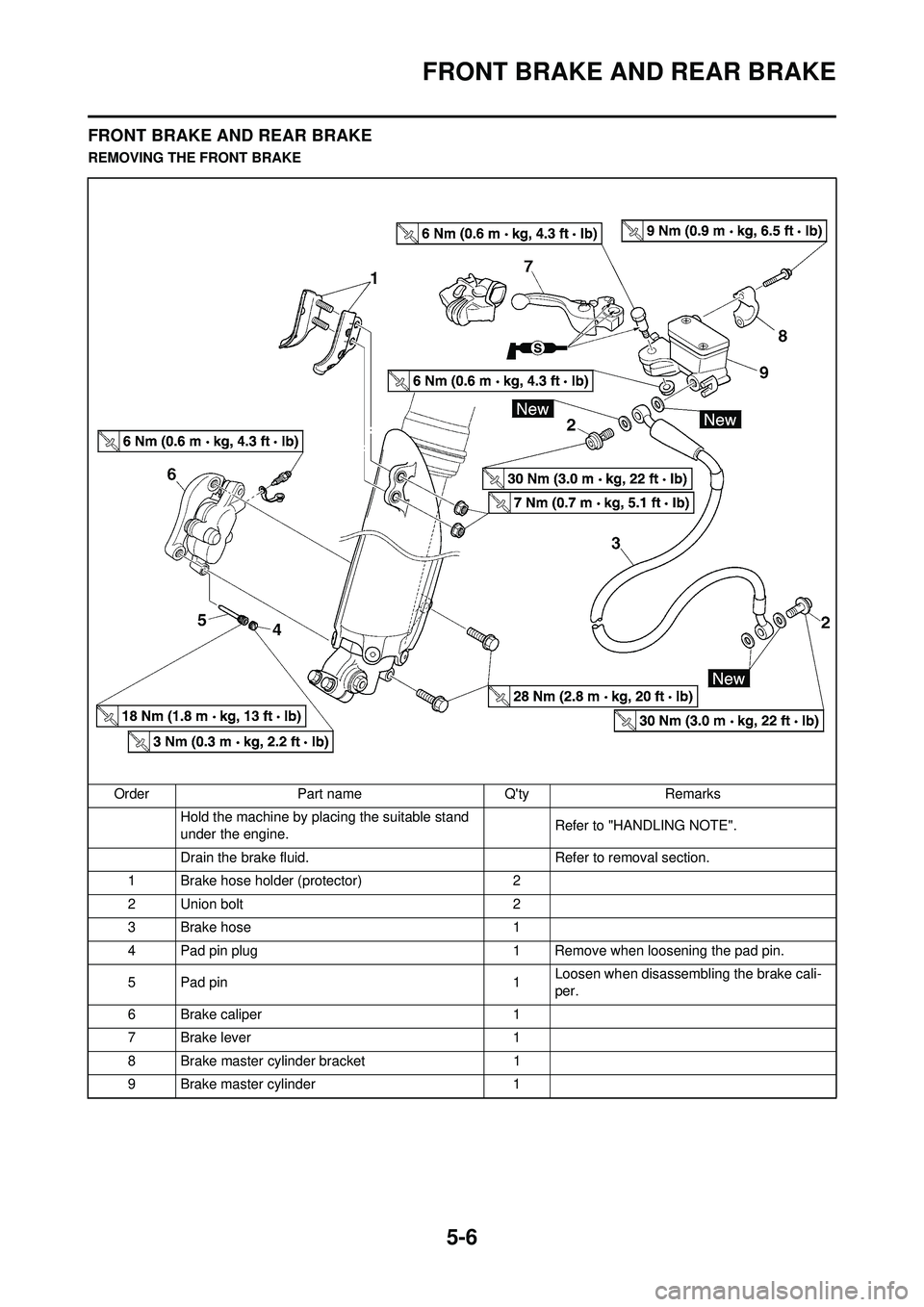
5-6
FRONT BRAKE AND REAR BRAKE
FRONT BRAKE AND REAR BRAKE
REMOVING THE FRONT BRAKEOrder Part name Q'ty Remarks Hold the machine by placing the suitable stand
under the engine. Refer to "HANDLING NOTE".
Drain the brake fluid. Refer to removal section.
1 Brake hose holder (protector) 2
2 Union bolt 2
3Brake hose 1
4 Pad pin plug 1 Remove when loosening the pad pin.
5 Pad pin 1Loosen when disassembling the brake cali-
per.
6 Brake caliper 1
7Brake lever 1
8 Brake master cylinder bracket 1
9 Brake master cylinder 1
Page 139 of 192
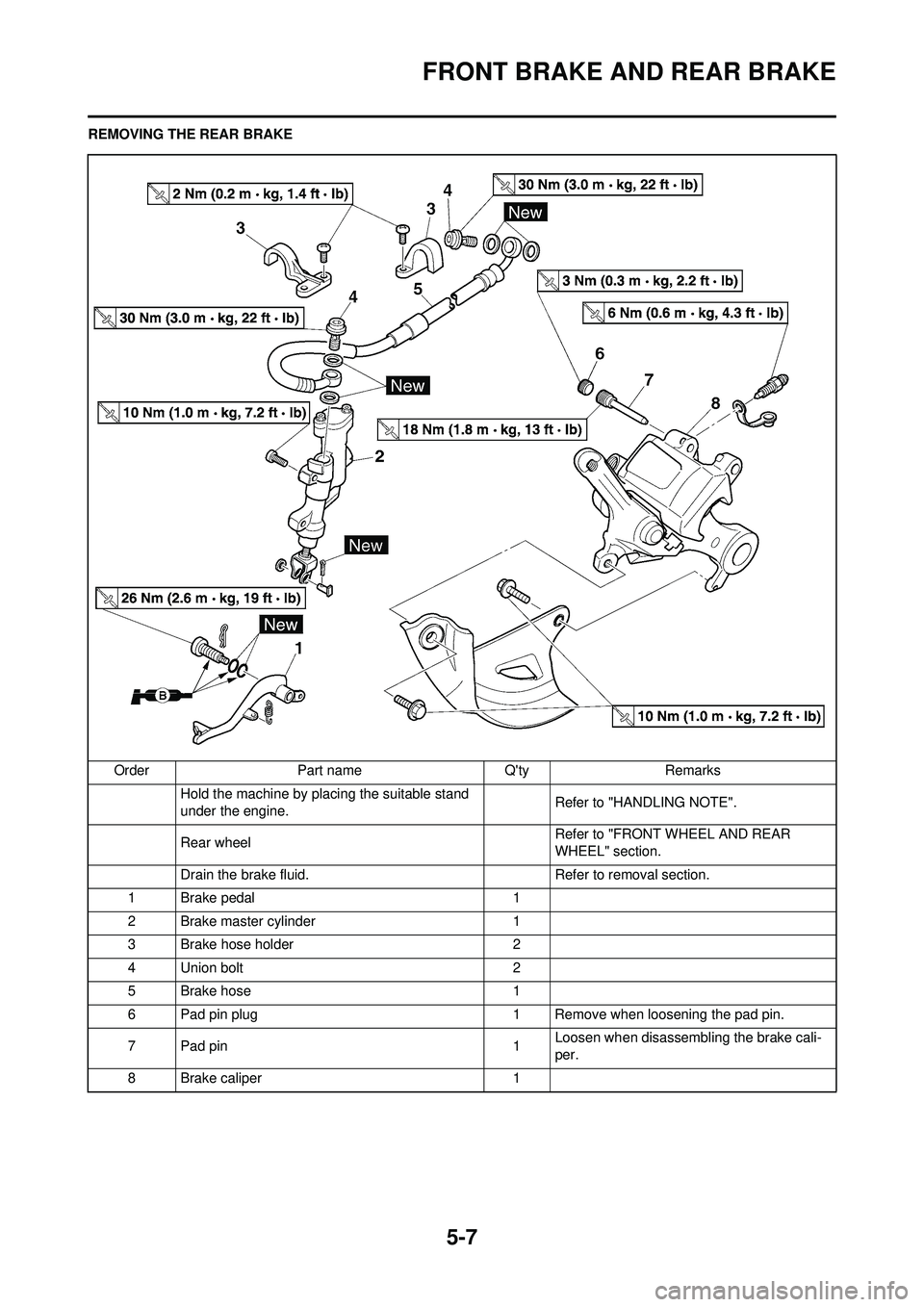
5-7
FRONT BRAKE AND REAR BRAKE
REMOVING THE REAR BRAKEOrder Part name Q'ty Remarks Hold the machine by placing the suitable stand
under the engine. Refer to "HANDLING NOTE".
Rear wheel Refer to "FRONT WHEEL AND REAR
WHEEL" section.
Drain the brake fluid. Refer to removal section.
1 Brake pedal 1
2 Brake master cylinder 1
3 Brake hose holder 2
4 Union bolt 2
5Brake hose 1
6 Pad pin plug 1 Remove when loosening the pad pin.
7 Pad pin 1Loosen when disassembling the brake cali-
per.
8 Brake caliper 1
Page 142 of 192
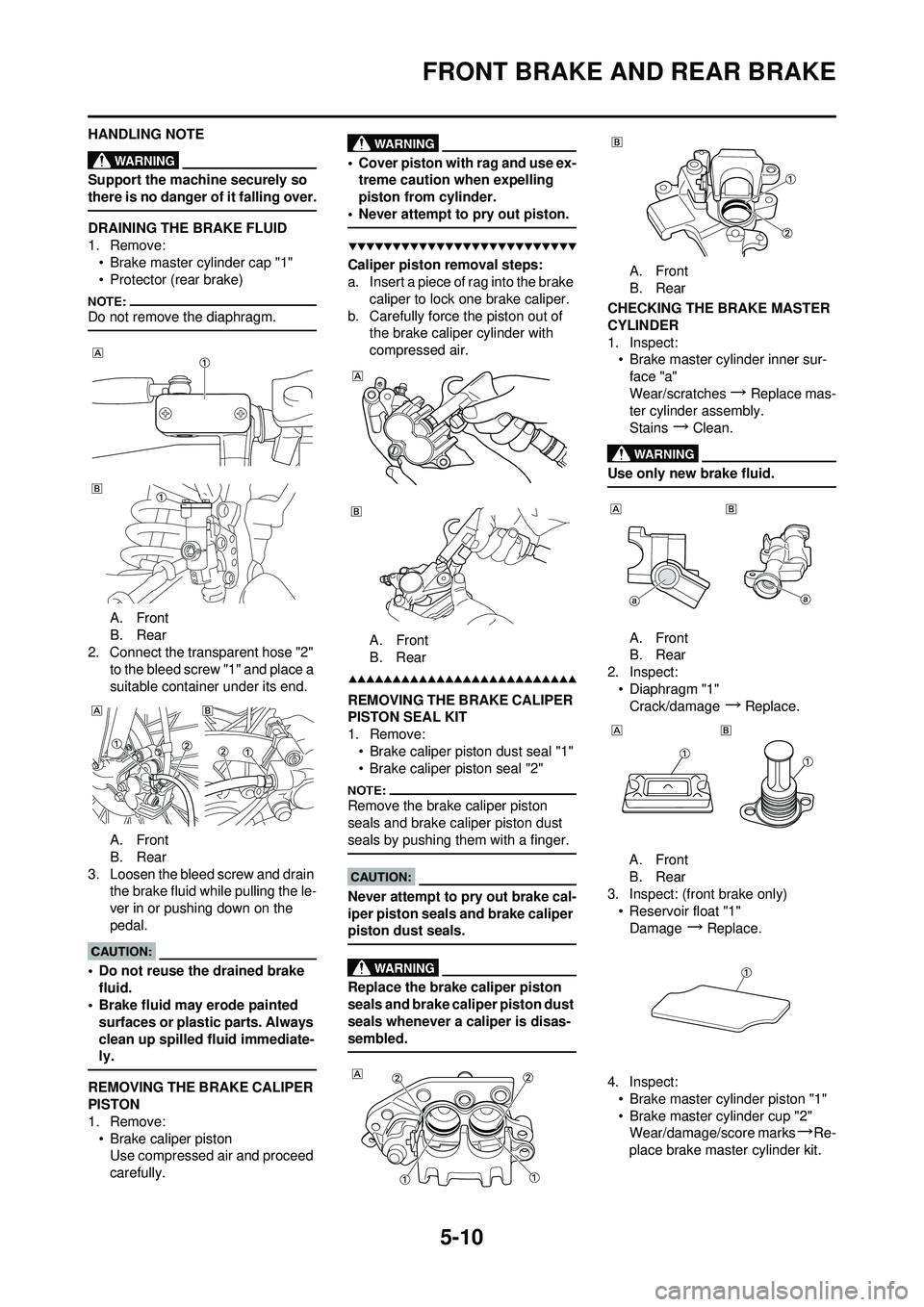
5-10
FRONT BRAKE AND REAR BRAKE
HANDLING NOTE
Support the machine securely so
there is no danger of it falling over.
DRAINING THE BRAKE FLUID
1. Remove:• Brake master cylinder cap "1"
• Protector (rear brake)
Do not remove the diaphragm.
A. Front
B. Rear
2. Connect the transparent hose "2" to the bleed screw "1" and place a
suitable container under its end.
A. Front
B. Rear
3. Loosen the bleed screw and drain the brake fluid while pulling the le-
ver in or pushing down on the
pedal.
• Do not reuse the drained brake
fluid.
• Brake fluid may erode painted
surfaces or plastic parts. Always
clean up spilled fluid immediate-
ly.
REMOVING THE BRAKE CALIPER
PISTON
1. Remove:• Brake caliper pistonUse compressed air and proceed
carefully.
• Cover piston with rag and use ex-treme caution when expelling
piston from cylinder.
• Never attempt to pry out piston.
Caliper piston removal steps:
a. Insert a piece of rag into the brake caliper to lock one brake caliper.
b. Carefully force the piston out of the brake caliper cylinder with
compressed air.
A. Front
B. Rear
REMOVING THE BRAKE CALIPER
PISTON SEAL KIT
1. Remove:
• Brake caliper piston dust seal "1"
• Brake caliper piston seal "2"
Remove the brake caliper piston
seals and brake caliper piston dust
seals by pushing them with a finger.
Never attempt to pry out brake cal-
iper piston seals and brake caliper
piston dust seals.
Replace the brake caliper piston
seals and brake caliper piston dust
seals whenever a caliper is disas-
sembled.
A. Front
B. Rear
CHECKING THE BRAKE MASTER
CYLINDER
1. Inspect: • Brake master cylinder inner sur-
face "a"
Wear/scratches
→ Replace mas-
ter cylinder assembly.
Stains
→Clean.
Use only new brake fluid.
A. Front
B. Rear
2. Inspect: • Diaphragm "1"Crack/damage
→Replace.
A. Front
B. Rear
3. Inspect: (front brake only)
• Reservoir float "1"Damage
→Replace.
4. Inspect: • Brake master cylinder piston "1"
• Brake master cylinder cup "2"Wear/damage/score marks
→Re-
place brake master cylinder kit.
Page 143 of 192
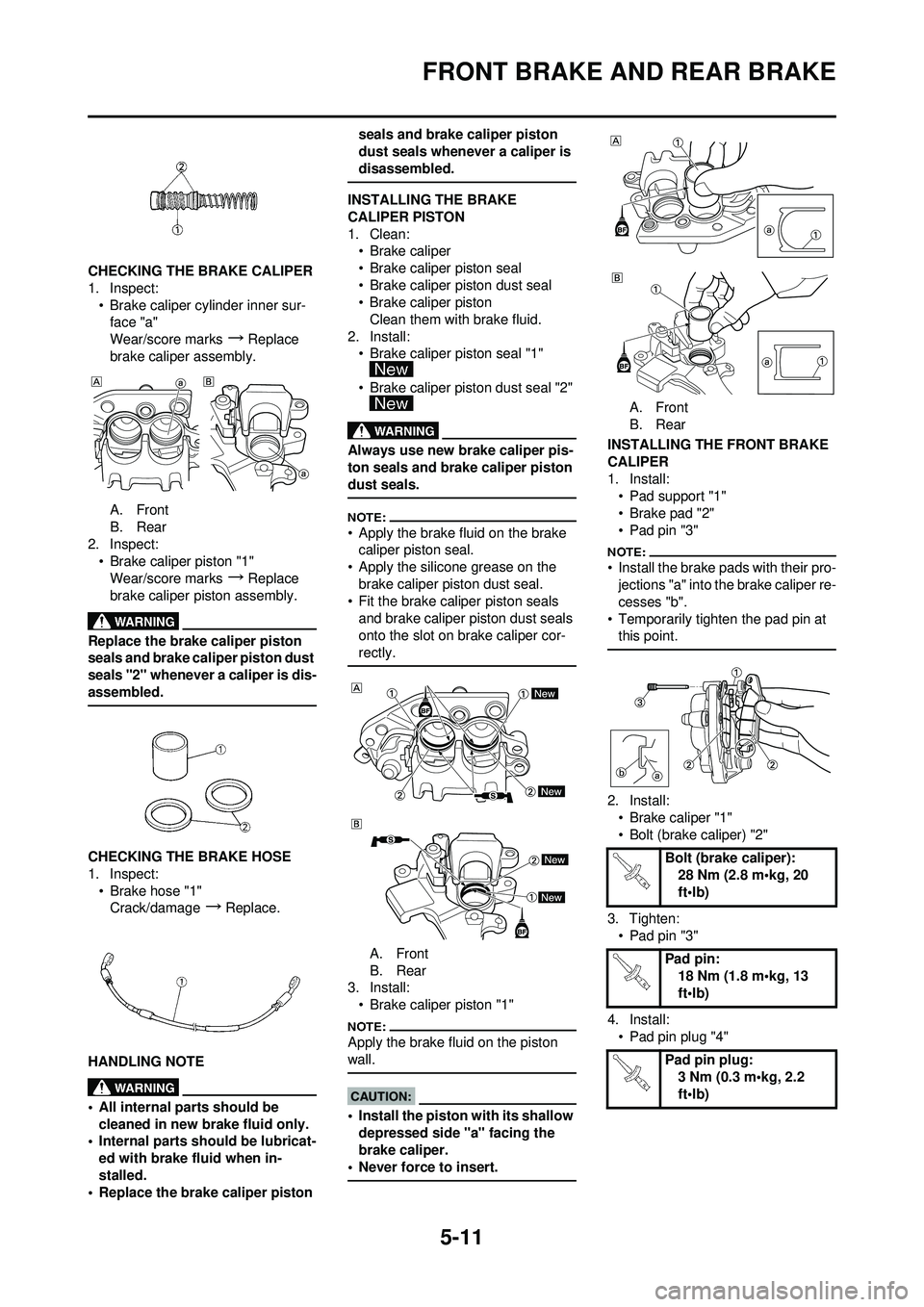
5-11
FRONT BRAKE AND REAR BRAKE
CHECKING THE BRAKE CALIPER
1. Inspect:• Brake caliper cylinder inner sur-face "a"
Wear/score marks
→Replace
brake caliper assembly.
A. Front
B. Rear
2. Inspect: • Brake caliper piston "1"
Wear/score marks
→Replace
brake caliper piston assembly.
Replace the brake caliper piston
seals and brake caliper piston dust
seals "2" whenever a caliper is dis-
assembled.
CHECKING THE BRAKE HOSE
1. Inspect: •Brake hose "1"Crack/damage
→Replace.
HANDLING NOTE
• All internal parts should be cleaned in new brake fluid only.
• Internal parts should be lubricat-
ed with brake fluid when in-
stalled.
• Replace the brake caliper piston seals and brake caliper piston
dust seals whenever a caliper is
disassembled.
INSTALLING THE BRAKE
CALIPER PISTON
1. Clean:
• Brake caliper
• Brake caliper piston seal
• Brake caliper piston dust seal
• Brake caliper piston
Clean them with brake fluid.
2. Install: • Brake caliper piston seal "1"
• Brake caliper piston dust seal "2"
Always use new brake caliper pis-
ton seals and brake caliper piston
dust seals.
• Apply the brake fluid on the brake caliper piston seal.
• Apply the silicone grease on the brake caliper piston dust seal.
• Fit the brake caliper piston seals and brake caliper piston dust seals
onto the slot on brake caliper cor-
rectly.
A. Front
B. Rear
3. Install:
• Brake caliper piston "1"
Apply the brake fluid on the piston
wall.
• Install the piston with its shallow depressed side "a" facing the
brake caliper.
• Never force to insert.
A. Front
B. Rear
INSTALLING THE FRONT BRAKE
CALIPER
1. Install: • Pad support "1"
• Brake pad "2"
• Pad pin "3"
• Install the brake pads with their pro-jections "a" into the brake caliper re-
cesses "b".
• Temporarily tighten the pad pin at this point.
2. Install:
• Brake caliper "1"
• Bolt (brake caliper) "2"
3. Tighten: • Pad pin "3"
4. Install: • Pad pin plug "4"
Bolt (brake caliper): 28 Nm (2.8 m•kg, 20
ft•lb)
Pad pin: 18 Nm (1.8 m•kg, 13
ft•lb)
Pad pin plug: 3 Nm (0.3 m•kg, 2.2
ft•lb)